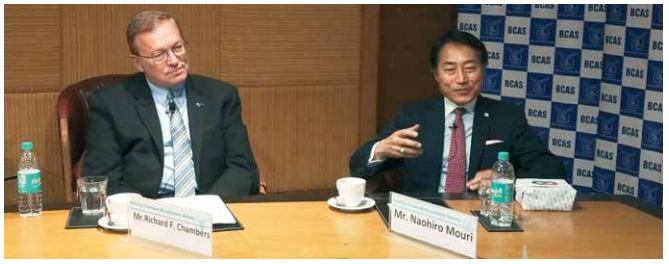16. [2019] 112
taxmann.com 55 (Trib.)(Mum.) ACIT vs. JSW Steel
Ltd. ITA No.
156/Bang/2011; CO No. 59/Mum/2012 A.Y.: 2006-07 Date of order: 29th
November, 2019
I. Section 43(6), Explanation 2 – In Explanation
2 to section 43(6), deprecation actually allowed shall not include any
unabsorbed depreciation – The WDV in the hands of the amalgamated company is to
be calculated without considering the unabsorbed depreciation of the
amalgamating companies, for which set-off was never allowed
II. When a receipt is held to be capital in nature
and not chargeable to tax under the normal provisions of the Act, the same
cannot be taxed u/s 115JB of the Act as well
III. Section 234B r/w/s 115JB – Interest u/s
234B cannot be levied where liability arises on account of retrospective
amendment in the Act
FACTS I
In the return of
income filed by the assessee for the year of amalgamation, i.e., A.Y. 2006-07,
the assessee computed WDV in respect of the assets transferred by the
amalgamating companies by reducing the amount of deprecation (‘actually
allowed’) in A.Y. 2005-06 in accordance with the provisions of Explanation (2)
to section 43(6) of the Act.
The AO observed
that the closing WDV of the amalgamating company becomes the WDV in the hands
of the amalgamated company and accordingly determined the WDV of the assets
acquired on amalgamation after considering normal depreciation allowed on
assets of the two amalgamating companies; consequently, he disallowed excess
depreciation of Rs. 6,81,27,607 (being 15% of the difference in the WDV of Rs.
45,41,84,048).
However, the AO was
of the view that Explanation (3) has to be read into Explanation (2) and
accordingly the WDV of the assets transferred on amalgamation has to be
computed after reducing the total depreciation in the hands of the amalgamated
companies.
Aggrieved, the
assessee preferred an appeal to the CIT(A) who allowed the appeal and directed
the AO to allow depreciation on the increased written down value of the assets.
Being aggrieved,
the Revenue preferred an appeal to the Tribunal.
HELD I
The Tribunal
observed that
(i) the only dispute under consideration is
whether the WDV of the assets transferred on amalgamation was to be computed in
the hands of the amalgamated company considering the unabsorbed depreciation,
i.e., depreciation not given effect to, in the assessment of the amalgamating
companies;
(ii) the provisions of Explanations (2) and (3) to
section 43(6) explains what will be the WDV of assets in the hands of the
amalgamated company in cases of amalgamation. Similarly, section 32(2) provides
for carry forward of unabsorbed depreciation and section 72A provides for carry
forward of business loss and unabsorbed depreciation in the hands of the
amalgamated company in cases of amalgamation;
(iii) on going through Explanation (2) to section
43(6), it is very clear that it speaks about depreciation ‘actually allowed’ in
relation to the said preceding year in case of the amalgamated company.
The Tribunal held
that in view of Explanation (2) to section 43(6) of the Act, the WDV in the
hands of the assessee as on 1st April, 2005 (the appointed date)
would be the WDV of block of assets as on 31st March, 2004 as
reduced by the depreciation ‘actually allowed’ during the said preceding year,
i.e., F.Y. 2004-05, in the hands of the amalgamating companies. Accordingly,
the WDV of assets transferred on amalgamation in the hands of the amalgamating
company has to be necessarily computed in terms of Explanation (2) to section
43(6) of the Act. In terms of this Explanation, while computing the WDV on
amalgamation, the depreciation actually allowed has to be reduced.
Since the case of
the AO was that Explanation (3) has to be read into Explanation (2) and,
accordingly, the WDV of assets transferred on amalgamation has to be computed
after reducing the total depreciation in the hands of the amalgamated
companies, the Tribunal found it necessary to read and comprehend as to why the
provision of section (3) to section 43(6) of the Act cannot be applied in the
facts of the present case. It held that Explanation (3) to section 43(6) states
that any depreciation which is carried forward u/s 32(2) shall be deemed to be
depreciation actually allowed. Further, it observed that Explanations (2) and
(3) to section 43(6) of the Act both used the term depreciation actually
allowed. However, as against Explanation (2), Explanation (3) to section 43(6)
of the Act operates as a deeming fiction, wherein depreciation which is carried
forward u/s 32(2) of the Act is deemed to have been actually allowed.
The Tribunal held
that in its view Explanation (3) being a deeming fiction, operates only in
particular conditions and in order to remove an anomaly which otherwise would
have been created under the other provisions of the Act. It held that while
interpreting Explanation (3) one needs to be aware of the intention of the
statute. These provisions, along with their intent, have been explained
elaborately by the Hon’ble Bombay High Court in the case of Hindustan
Petroleum Corporation Limited where it was held that Explanation (3) to
section 43(6) seeks to find certain anomalies which would have otherwise
existed under the Act. The intention of Explanation (3) is not simply to
nullify the provision of Explanation (2) to section 43(6), as has been read by
the AO. This is also evident from the fact that Explanation (2) has been
introduced from 1st April, 1988, whereas Explanation (3) was always
on the statute, which clearly implies that Explanation (3), which is a legal /
deeming fiction, was not introduced to nullify the impact of Explanation (2) of
the Act.
Accordingly, in
terms of Explanation (3) to section 43(6), in the present case, unless the
unabsorbed depreciation of the amalgamating companies is carried forward in the
hands of the amalgamated company u/s 32(2), Explanation (3) cannot be read into
Explanation (2) to simply conclude that depreciation ‘actually allowed’ also
includes unabsorbed depreciation.
It observed that in
view of the ratio of the decision of the Supreme Court in the case of CIT
vs. Doom Dooma India Ltd. [2009] 310 ITR 392, the words actually
allowed under Explanation (2) only mean depreciation, which has been given
effect to in the computation of income of the amalgamating companies and will
not include unabsorbed depreciation. This legal proposition, it observed, is
also supported by the decision in the case of Silical Metallurgic Ltd.
where the Hon’ble Court held that the statutory provision makes it clear that
the WDV of the asset would be the actual cost of the assets of the assessee
less depreciation allowed to the company. Any unabsorbed depreciation, which
was not set off for carry forward could not be taken into account.
A similar view was
taken by the Bombay High Court in the case of Hindustan Petroleum Corpn.
Ltd. and a Special Leave Petition filed against the aforesaid High
Court decision has been dismissed by the Hon’ble Supreme Court on merits in SLP
(C) No. 19054 of 2008 (SC). A similar proposition has been laid down by
the Hon’ble Madras High Court in the case of EID Parry India’s vs. CIT
[2012] 209 Taxmann 214. The Courts have, considering the applicability
of provisions of section 72A, held that deprecation actually allowed shall not
include any unabsorbed depreciation.
The Tribunal held
that the WDV in the hands of the amalgamated company was to be calculated
without considering the unabsorbed depreciation of the amalgamating companies,
for which set-off was never allowed. The Tribunal upheld the findings of the
CIT(A) and dismissed this ground of the appeal of the Revenue.
FACTS II
The assessee
received a sales tax subsidy of Rs. 36,15,49,828 from the Karnataka Government
for setting up a new industrial unit in the backward area of the state. The
refund of sales tax subsidy was routed through the profit and loss account and
hence the same was considered as part of the book profits u/s 115JB of the I.T.
Act, 1961. Subsequently, the assessee realised that sales tax subsidy being
capital receipt as held by the CIT(A), the same is not taxable under the MAT
provisions; accordingly, the issue was raised before the Tribunal and this
ground was taken by the assessee in the cross-objections filed by it.
HELD II
The Tribunal noted
that
(i) the Coordinate Bench of the ITAT, Mumbai
Tribunal, in the assessee’s own case for A.Y. 2004-05 in ITA No. 923/Bang/2009,
had considered an identical issue and held that where a receipt is held to be
capital in nature not chargeable to tax under the normal provisions of the Act,
the same cannot be taxed u/s 115JB of the I.T. Act, 1961;
(ii) the Hon’ble Kolkata High Court, in the case of
Pr. CIT vs. Ankit Metal & Power Ltd. [2019] 109 taxmann.com
93 had considered an identical issue and after considering the decision
of the Hon’ble Supreme Court in the case of Apollo Tyres Ltd. (Supra)
held that when a receipt is not in the character of income as defined u/s 2(24)
of the I.T. Act, 1961, then it cannot form part of the book profit u/s 115JB.
The Court further observed that the facts of case before the Hon’ble Supreme
Court in the case of Apollo Tyres Ltd. were altogether different,
where the income in question was taxable but was exempt under a specific
provision of the Act, and as such it was to be included as a part of book
profit; but where the receipt is not in the nature of income at all, it cannot
be included in book profit for the purpose of computation u/s 115JB.
The Tribunal
further noted that to a similar effect was the ratio of the following
decisions:
(a) Sutlej Cotton Mills
Ltd. vs. Asstt. CIT [1993] 45 ITD 22 (Cal. Trib.) (SB);
(b) Shree Cement Ltd. vs.
Addl. CIT (2015) 152 ITD 561 (Jai. Trib.);
(c) Sipca India (P) Ltd.
vs. Dy. CIT [2017] 80 taxmann.com 87 (Kol. Trib.).
As regards the case
laws relied upon, on behalf of the Revenue, the Tribunal held that the Tribunal
or High Court in those cases came to the conclusion that the capital receipt is
in the nature of income, but by a specific provision the same has been exempted
and hence came to the conclusion that once a particular receipt is routed
through the profit and loss account, then it should be part of book profit and
cannot be excluded while arriving at book profit u/s 115JB of the Act, 1961.
The Tribunal held
that when a particular receipt is exempt from tax under the Income tax Law,
then the same cannot be considered for the purpose of computation of book
profit u/s 115JB. It directed the AO to exclude the sales tax subsidy received
by the assessee amounting to Rs. 36,15,49,828 from the book profits computed
u/s 115JB.
The cross-objection
filed by the assessee was allowed.
FACTS III
Section 234B
r/w/s 115JB – Interest u/s 234B cannot be levied where liability arises on
account of retrospective amendment in Act
While completing
the assessment, interest of Rs. 9,84,94,367 was levied on total income computed
u/s 115JB on account of retrospective amendment to section 115JB. In the profit
and loss account for the year ended 31st March, 2006, the assessee
had debited provision for deferred tax of Rs. 433.61 crores. In the return of
income filed for A.Y. 2006-07, the aforesaid provision was not added back while
computing book profit u/s 115JB. However, subsequently the Finance Act, 2008
made a retrospective amendment to section 115JB by inserting clause (h) in
Explanation 1 to section 115JB according to which book profits are required to
be increased by an amount of deferred tax and provision thereof; the said
amendment was made with retrospective effect from A.Y. 2001-02. Accordingly,
during the course of assessment proceedings while computing book profits u/s
115JB, the AO, in view of the insertion of clause (h) in Explanation 1 to
section 115JB by the Finance Act, 2008 with retrospective effect, added the
provision for deferred tax liability and consequently interest u/s 234B was
levied which interest arose on account of the retrospective amendment to
section 115JB.
Aggrieved, the
assessee preferred an appeal to the CIT(A) who allowed the appeal on the ground
that no liability can be fastened onto the assessee on the basis of
retrospective amendment to the Act.
HELD III
The Tribunal noted
that whether interest us/ 234B can be charged on the basis of a retrospective
amendment on recomputed book profit is no longer res integra. The
Coordinate Bench of the ITAT Bangalore Tribunal, in the assessee’s own case for
A.Y. 2005-06 in ITAT No. 924/Bang/2009, had considered an identical issue and
held that no interest can be levied u/s 234 B where liability arises on account
of retrospective amendment in the Act.
It observed that in the current year as well, the liability for interest
u/s 234B has arisen only on account of a retrospective amendment to the
provision of section 115JB. Accordingly, the assessee would not have
anticipated the retrospective amendment at the time of making the payments for
advance tax, but would have estimated the liability to pay advance tax on the
basis of the then existing provisions. The Tribunal found no error in the
findings recorded by the CIT(A), while deleting the interest liability u/s 234B
of the Act. The Tribunal upheld the findings of CIT(A) and rejected the ground
taken by the Revenue. This ground of appeal of the Revenue was dismissed.









